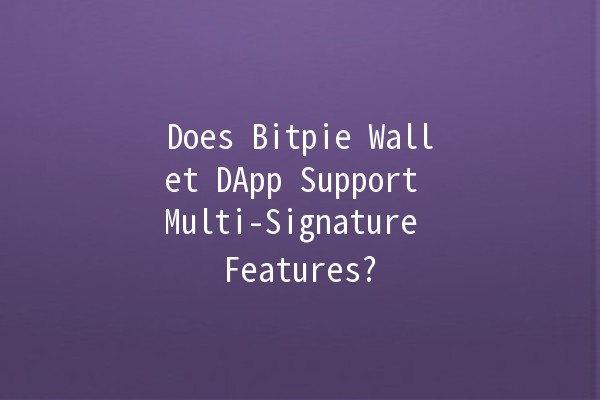




In the world of cryptocurrency wallets, Bitpie Wallet stands out due to its versatile functionalities and robust security protocols. Bitpie Wallet is a decentralized application (DApp) that allows users to manage their digital assets securely, facilitating transactions across multiple blockchain networks.
One of the critical discussions in the realm of digital wallets is the implementation of multisignature (multisig) features. This article will explore whether Bitpie Wallet DApp supports multisignature functionalities, which are crucial for enhancing security, and how they function within the ecosystem of cryptocurrency transactions.
Multisignature technology refers to a security protocol that requires more than one private key to authorize a transaction. In essence, it adds a layer of security by ensuring that multiple parties must agree before any action, like spending funds, can be executed. This feature is particularly beneficial for businesses or groups managing shared assets, enhancing accountability and preventing unauthorized access.

In a typical multisignature setup, a defined number of keys, or signatures, is needed to approve a transaction. For example, a 2of3 multisig wallet requires any two out of three designated keys to authorize a transaction. This arrangement can significantly reduce the risk of theft, as compromising a single key cannot lead to unauthorized transactions.
Before delving into multisignature support, it's essential to understand the overall security framework of Bitpie Wallet. The platform employs a range of security protocols to protect users' assets, including:
Private Key Management: Users have complete control over their private keys, unlike centralized wallets where third parties manage keys.
Cold Storage Options: Users can opt for offline storage to safeguard their digital assets from online attacks.
Regular Updates: The platform consistently updates its security features to address emerging threats in the cryptocurrency landscape.
As of now, Bitpie Wallet does not natively incorporate multisignature functionality within its DApp. However, this should not deter users from securing their assets comprehensively. Instead, users can implement several alternative strategies to safeguard their digital currencies effectively.
Explanation: Employ a strong, unique password for your Bitpie Wallet account. A robust password is your first line of defense against unauthorized access.
Example: Use a combination of uppercase letters, lowercase letters, numbers, and special characters to create a password of at least 12 characters. For instance, “C0mpl3x_P@ssw0rd!” is much harder to guess than “password123”.
Explanation: Adding another layer of security by enabling 2FA can significantly bolster the account protection of your Bitpie Wallet.
Example: Use an authenticator app like Google Authenticator or Authy. Even if someone obtains your password, they must still have access to the second factor to log in.
Explanation: Always keep a secure backup of your wallet data, including seed phrases or private keys.
Example: Store your backup offline on encrypted USB drives or paper formats kept in a secure location, minimizing risks of loss due to hardware failure or cyberattacks.
Explanation: Phishing scams targeting cryptocurrency users are prevalent. Be vigilant and only access your wallet from official websites and apps.
Example: Always doublecheck URLs and email addresses, and never click on links from unknown sources, as these can lead to fake websites designed to steal your credentials.
Explanation: Do not keep all your digital assets in one wallet. Diversifying your holdings across different wallets can mitigate risks.
Example: Allocate a portion of your cryptocurrency to Bitpie Wallet and other hardware wallets that support multisignature features, spreading out risk in case of a breach.
Multisignature wallets enhance security by requiring multiple private keys to authorize transactions, minimizing the risk of fraud and ensuring that significant funds cannot be accessed without the consensus of multiple parties.
While Bitpie Wallet provides robust security measures, its current design does not include multisignature functionalities. However, users can adopt alternative methods to protect their assets.
Always write down your recovery seed phrase and store it in a fireproof and waterproof safe. Consider using a secure digital vault or encrypted USB drive that only you can access.
Yes, you can pair Bitpie Wallet with compatible hardware wallets that support multisignature features. This setup allows you to secure your assets while enjoying the functionality of the Bitpie interface.
Like any digital wallet, Bitpie Wallet is susceptible to various risks, including phishing attacks and hardware failures. However, employing best security practices can significantly reduce these risks.
Yes, Bitpie Wallet supports connectivity to various decentralized applications, allowing users to interact with different blockchain services seamlessly.
, while Bitpie Wallet DApp does not currently support multisignature functionalities, it remains a robust option for cryptocurrency management. By incorporating recommended security practices and considering alternative solutions for shared asset management, users can effectively safeguard their digital assets. The importance of enhancing security in the evolving landscape of cryptocurrency cannot be overstated, and it is crucial for users to remain informed and vigilant in their practices.